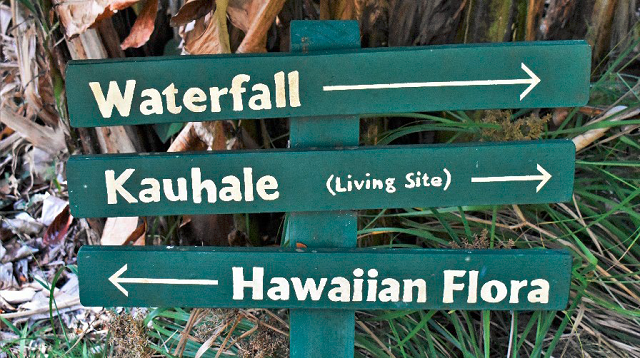Waimea Valley is home to over 5,000 different species of plants. Each pecies is part of a living library maintained by the incredible staff of Waimea Valley Gardens. We care for a variety of plants from around the world that are extinct, endangered, or threatened out in the wild. Here they find a home that allows their species to exist in perpetuity. Although all of these plants are considered exceptional, a special few are closer to our hearts; these are our native Hawaiian species.
Most Hawaiian species arrived by luck to this, the most remote island chain in the world. From these single ancestors, unique species evolved that can be found nowhere else in the world. These endemic, or native species, colonized the islands in such vast numbers that Hawaii is home to highest rate of endemism in the world. Because many of these plants are so unique and rare, they are also exceptionally vulnerable to extinction. Hawaiian plant species are currently in danger for a number of reasons. The most prominent of which are habitat loss and destruction for cattle, farming etc, competition by non-native, or introduced species, and loss of birds or other species that would disperse these plants, through their seed, around the forest. These factors have caused the numbers of native plants to drop significantly and therefore, here at Waimea, we have added them into our living library in order to preserve a piece of cultural and historical information about the natural environment of Hawaii.
While the Ohia may be the most charismatic and notable of the native species in the race for conservation, there are many others that are in need of protection before they quietly disappear forever. One such plant is the Ma‘o hau hele, Hawaiian hibiscus, or Hibiscus brackenridgei. This large yellow hibiscus was declared Hawaii’s state flower in the 1980’s and is found on every large Hawaiian island. Although found on every island, the species is in no way common. The last few pockets of species have recently been affected by natural disaster and are dwindling at an unprecedented rate. At Waimea this bright yellow flower is visible and vigorous in several native gardens, a sign of conservation in action for this now rare and beautiful species.
In addition to the showy Hibiscus, there is a small butterfly shaped fern that is becoming more and more scarce in the wild. The Marsilea villosa, or ‘ihi‘ihi, was federally listed as endangered in 1992 but populations on the island chains have been able to persist, barely, with less than 2,000 individuals remaining in only four sites throughout the islands. These ferns exist in ephemeral wetlands or pools. The seasonal flooding of these pools allowing this sensitive fern to procreate in time with the rising and falling of the waters. At Waimea, through propagation efforts by our staff, this fern has been given new life. With a robust population now in our nursery and in the park, this fern is available for purchase at Saturday plant sales. This addition to your garden or windowsill, properly cared for, will not only be a beautiful native Hawaiian plant but also your contribution to conservation of the natural Hawaiian environment.
These are only two of many native plants that are either endangered or threatened here on Oahu and throughout the Hawaiian island chain. Through preserving these species, we hope to create populations that will exist for future generations to enjoy. Places such as Waimea Valley act as a conservation hub safeguarding these species against future threats, not only against Hawaiian native species but for all of the exotic and beautiful species that now call Waimea Valley their home.



